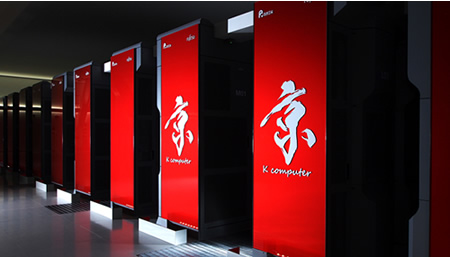

What is K?

RIKEN’s K computer belongs to the highest caliber of supercomputers in the world.
While maintaining a high status for its speed, the K computer was designed with a high priority given to ease of use. Here we introduce you to several of its key advantages.
For post-K computer development, visit FLAGSHIP 2020 Project website.
Advantage 1
Versatility
K computer is being used in a broad range of fields including drug discovery, earthquake/tsunami research, weather forecasting, space science, manufacturing and material development. K computer is openly available for use by researchers throughout the world. Many scientists and technical researchers from institutes, universities and industry are currently using the K computer. Software is continually being developed and ported to K. The supercomputer is becoming useful in even more areas.
Advantage 2
Changing our future
K’s fast calculation speed allows high-resolution simulations which had not been possible before, leading to new discoveries and the opening of new research fields. A simulation of the human heart which had taken two years, for instance, is accomplished in just one day. Obtaining heart simulations in a short time is expected to contribute to the field of cardiology by gaining a more accurate understanding of heart disease mechanisms. Also, K computer can provide a breakthrough in the area of drug discovery. These are but two examples of how K computer is being used to brighten our future.
Research Highlights
Advantage 3
Fast and stable
Not only does it use high quality CPUs, K’s network and memory functions are also top-notch. With a high priority on reliability and stability, if there happens to be any malfunctioning CPU component, K is designed to bypass the defective CPU, allowing it to continue calculations using the rest of the CPUs. Defective parts are replaced without stopping an operation of the K computer.
Advantage 4
Energy efficiency
All of K’s components, including its power source and cooling facilities―as well as the system as a whole―are designed to be highly energy efficient. In June, 2011, when it was first rated in the TOP500 list, K placed sixth in the GREEN500 energy efficiency ranking, an excellent result for such a large-scale supercomputer. Other energy conservation features include solar power generation, use of heat from cogenerators and reuse of rainwater.

